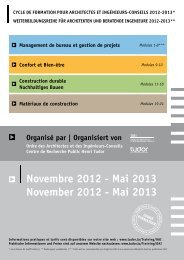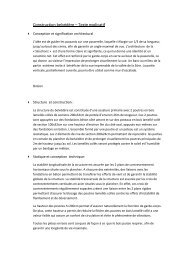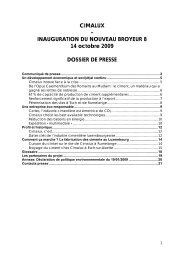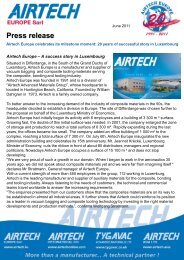40 YEARS OF DELPHI IN LUXEMBOURG - Revue Technique ...
40 YEARS OF DELPHI IN LUXEMBOURG - Revue Technique ...
40 YEARS OF DELPHI IN LUXEMBOURG - Revue Technique ...
Create successful ePaper yourself
Turn your PDF publications into a flip-book with our unique Google optimized e-Paper software.
10 HORS SERIE #002 | REVUE TECHNIQUE <strong>LUXEMBOURG</strong>EOISE<br />
Source: European Council for Automotive R&D (EUCAR) Working Group Powertrain Roadmap for<br />
research needs in light-duty powertrain technologies 8 November 2010 - Brussels<br />
Therefore, it is essential that - in parallel to research and<br />
development of components and systems for electrification<br />
of the vehicle - focus must remain on the internal combustion<br />
engine for light-duty vehicles to ensure its contribution<br />
to sustainable mobility. Decarbonization of the internal<br />
combustion engine itself will be achieved through efficiency<br />
improvements and the application of low carbon fuels, particularly<br />
biofuels. Even though internal combustion engines<br />
already have reached a very high level of maturity, they still<br />
offer potential for further refinements that need to be exploited<br />
in research programs.<br />
The diesel engine has become very popular due to its low<br />
fuel consumption and high torque provided by turbocharging.<br />
However there is a tradeoff for emissions with higher<br />
NO and NO 2 (commonly grouped as NOx) numbers for diesel<br />
engines. This drives higher exhaust after-treatment cost.<br />
In both areas though, there is great potential in downsizing<br />
and turbocharging, leading to a combination of diesellike<br />
torque and fuel consumption characteristics with the<br />
gasoline-type noise and power benefits. Future combustion<br />
modes like HCCI (homogeneous charge compression ignition)<br />
are under development, combining both principles in<br />
the same engine.<br />
The direct injection technology, where fuel is injected directly<br />
into the cylinder, allows much better control of fuel quantity<br />
and preparation, and therefore higher engine efficiency. The<br />
injector has to meter in a precise and timely fashion quantities<br />
as low as 1 mg of fuel to the combustion chamber, and<br />
this up to five times during each cylinder cycle. This allows to<br />
control the combustion process such that maximum energy<br />
is delivered and minimum unburned fuel or particulates are<br />
generated. This technology operates with fuel pressures of<br />
200 bar for gasoline and 2,000 bar for diesel to generate<br />
a spray pattern able to provide stable and clean combustion<br />
under all conditions. This injection technology requires<br />
massive investment in research equipment, simulation and<br />
manufacturing equipment capable of producing a precise<br />
and durable product that will perform during the entire life<br />
of the vehicle under all environmental conditions.<br />
_State-of-the art fuel injection systems<br />
The heart of the engine management system is the fuel<br />
injection system, the brain is the electronic control unit. Delphi<br />
develops and produces both diesel and gasoline engine<br />
management systems and drives new technology for future<br />
improvement of fuel combustion and performance. This<br />
includes additional components like hydraulic and electric<br />
cam phasers, exhaust gas sensors and ignition systems.<br />
Direct injection technology and turbocharging allows for<br />
extracting more power from the engine or, inversely, engines<br />
can be downsized while generating the same power<br />
as before. This saves cost, weight and fuel. Delphi‘s Direct<br />
Acting Piezo Injector won a prestigious 2010 Automotive<br />
News PACE Award (Premier Automotive Suppliers’ Contribution<br />
to Excellence).<br />
When comparing different engine concepts for their cost<br />
and CO 2 benefits, there is an interesting relation between<br />
the cost of technology (as seen by the vehicle manufacturer)<br />
and the possible CO 2 improvement potential. Green<br />
datapoints are gasoline, yellow and brown datapoints are<br />
diesel engines. For example, a downsized 3-cylinder Gasoline<br />
Direct Injection (GDI) engine has a similar CO 2 /cost ratio<br />
than a good diesel engine.<br />
_Energy Efficient Air Conditioning units<br />
Air conditioning and thermal management systems need<br />
to follow the same trend of reduced environmental impact<br />
while maintaining or increasing their performance. The Delphi<br />
Thermal division in Bascharage develops components<br />
and full systems solutions for cabin heating, ventilation and<br />
air conditioning. In addition, radiators and other heat exchanger<br />
solutions are developed for engine cooling, charge<br />
air cooling and exhaust gas recirculation.<br />
The next Generation Energy Efficient Air Conditioning units<br />
will contribute to CO 2 reduction due to reduced power
















